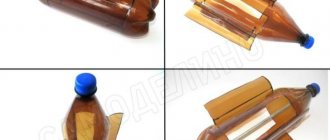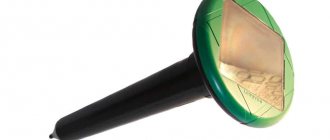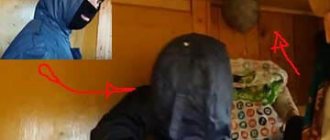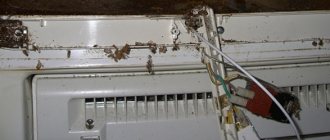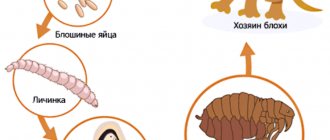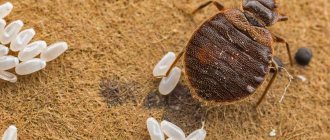Why is a mole dangerous on the site?
The mole is a small mammal that lives primarily underground. It is insectivorous. Weighs from 10 to 70 g, its body length is from 5 to 20 cm. The body is covered with dark or black velvety fur. The mole's pile grows straight to the top, which allows it to move underground without problems, both forward and backward. The front paws with large claws look like shovels; the animal uses them to dig holes in the ground, screwing its muzzle and body into the hole; the hind paws are much weaker.
On a note! Poor vision or its complete absence is compensated by an excellent sense of smell and touch.
Shallow underground, the animals break through a network of feeding passages into which earthworms crawl. They are the main food of this animal; in addition to them, slugs, wood lice, chafer larvae, mole crickets, as well as frogs and even snakes are also eaten. Moles are incredibly voracious. They are cannibals; if you leave two hungry moles together for a long time without food, then soon a fight will begin between them and the stronger one will dine on the weaker one.
Since a mole cannot gnaw the ground with its teeth like a shrew, but digs passages only with the help of its paws, it prefers loose soil in forests and fields to live. It builds its burrows at a depth of 1.5-2 m, and a lot of earth is thrown to the surface. The appearance of such loose tubercles on the soil should alert summer residents.
Mole
The underground beast does not feed on plant roots, but damages them by digging holes for itself, thereby causing great damage to the crop. There is another disadvantage of having a mole on the site. Earth rats live in old mole holes and use the dug passages. A few rats are capable of destroying an entire crop of potatoes or carrots, completely chewing off the entire root crop underground, leaving only the top sticking out of the ground and the tops.
How a mole net works, pros and cons
Hillocks that appear in a garden plot indicate that moles have settled underground. These hardworking animals love soft, fertile soil, where there are plenty of worms and insect larvae. Unfortunately, people are not happy with such a neighborhood. It is easy to fall into a molehill and get seriously injured. Rodents live there, causing damage to plants, buried cables and pipes. Therefore, summer residents enter into a stubborn struggle with unwanted diggers. One of the best ways to keep underground neighbors out is a metal or plastic mole net.
Let's figure out what it is, how it works, and whether it really protects against problematic burrowing insectivores.
Features of the body structure and life of moles
Small mammals look funny and clumsy only in photographs. In reality, these are quite nimble predators, with a body length of up to 17 cm. They live exclusively in burrows and are afraid of free spaces. They leave safe shelters only for a short time at night if they want to move to another habitat. The weight of an adult is approximately 70 g.
Moles mate deep in the soil; every year the female bears 1-2 offspring. Short, very thick and soft fur with a pile strictly perpendicular to the surface of the skin makes it easier to move in any direction. The mole moves backward just as well as it moves forward, without getting its fibers stuck in a narrow hole.
The main danger for summer residents is the animal's front paws, with large claws and strong muscles. Throwing soil up through holes that are also needed for air access, the mole digs up to 20 m of tunnels per day. The practically blind animal with tiny beady eyes has sensitive hearing and an excellent sense of touch, so it successfully avoids bait and traps. More effective methods of getting rid of moles are needed.
You can't catch them with your hands. They have a fierce character and sharp teeth. In addition, all mammals suffer from rabies, including the smallest ones.
The greatest benefit comes from mole netting, which you can buy online. You just need to correctly calculate how much protective material is required for the area.
How does an anti-mole protective net work?
The mesh fabric is a continuous network of strong fibers, without holes larger than the cells. The mole is able to penetrate even a small hole, expand and stretch the weak point in the barrier. Therefore, manufacturers pay special attention to the strength of the material.
Cells that are too small can make it difficult for oxygen to reach plant roots. The best choice is holes with a side length of about 25 mm. The principle of operation of the network is simple and clear. The canvas is buried in the ground in some cases to a depth of up to a meter. Moles do not like to dig holes with differences in height; they prefer straight tunnels. Having stumbled upon an obstacle, they dig sideways, without penetrating into the area fenced with a net. In this way, a protected area is fenced around the perimeter, and pests do not penetrate there.
Choice of material and installation nuances
For greater reliability, in addition to vertical placement of the mesh fabric, horizontal laying is practiced. Then it will be impossible to dig down to bypass the barrier at depth.
There are nets made of metal, although they are more durable at first than those made of plastic, but they are not resistant to corrosion. In the presence of moisture and substances dissolved in soil waters, even fairly resistant alloys corrode. Plastic braid is much more durable. Polypropylene is most often used to make mole nets. This is a practical and inexpensive anti-mole net, price
which is usually lower compared to metal.
There is a considerable amount of work ahead. It is necessary to dig trenches by hand or use machinery. You should not save on simplifying barriers, otherwise the main point of installing protective structures may be lost. A relatively large amount of material will be required. Fortunately, you can buy mole netting in Moscow at a price
, acceptable to everyone, is not so difficult. An extra few square meters is unlikely to significantly increase the cost of arranging a household plot.
The most common method is to lay the canvas vertically around the perimeter of the garden. If part of the territory is fenced with a fence on a deep strip foundation, a mole net is also needed there; it is dug in from the inside. But first you need to make sure that there are no moles left in the fenced area.
Under garden lawns, especially those with artificial turf, the net is placed horizontally along its entire length. Additionally, they are fenced on the sides, then the valuable lawn coverage will be completely protected. It is enough to raise the natural soil by 10-15 cm; the depth of the excavation when using external turf depends on its thickness.
The individual parts of the fence must be carefully connected so that there are no small gaps left. For greater reliability, polypropylene thread or tape is passed through the contacting cells, sometimes tying knots. Such weaving will become absolutely impregnable for the mole.
A significant problem for the gardener is the presence of other harmful animals on the site, for example, mole rats. Mole rats cope much better with polypropylene threads than mice, voles or shrews. At the same time, a thick metal network is expensive, and still subject to rapid corrosion.
If there are rats, it is also useless to block their path with such a weak obstacle. Unlike insectivores, rodents, especially large ones, can easily chew through even thick sheets of plastic, not to mention threads. Only metal can deter rats to some extent.
A combination of buried mesh laying with a “barrier” up to 30 cm high on the surface helps against most small rodents and insectivores. This vertical structure is suitable for beds, but in flower beds it often disrupts the attractiveness of flower beds. Compared to the white one, the black network is not so noticeable.
Advantages and disadvantages of mole nets
The benefits include:
- sufficient strength;
- long service life;
- no need for repairs;
- gentle treatment of wild animals;
- protection from most rodents.
The disadvantages are the following:
- a significant amount of earthworks;
- reproduction of animals remaining on the site;
- difficulties when plowing the area around the edges;
- difficulties when manually digging near the barrier.
Considering the pros and cons, we can conclude that a mesh barrier is more suitable for decorative areas. If the land is plowed annually, at a minimum you will have to carefully dig up the soil along the edges by hand, carefully picking out weeds with your hands at the very border of the fenced area. Surely the net will be useful in a garden with fruit trees, where only small “circles” are dug near the trunks.
mole netting is very effective for fighting insectivores
, available to all summer residents, it can be found in the online store. In winter, when there is no active work in the garden, there are more discounts and promotions on quite high-quality canvases.
Grid installation
One of the main methods of combating underground animals is an anti-mole net. It is a plastic or metal mesh covering, which, due to the small size of the cells, prevents moles from entering the area. At the same time, they do not interfere with the growth of plants that grow through the holes. Can be installed both horizontally and vertically. The metal mesh is strong, but short-lived; it quickly rusts in the ground and a mole can destroy it. Therefore, meshes made from polymers are in greatest demand. Their shelf life is unlimited, you can bury them once on the site and forget about moles forever.
Mole net
Cucumber net
Method of laying mesh for arranging a lawn:
- Remove the top layer of soil.
- Lay the mesh and secure it with staples along the edges.
- Place 5-10 cm of fertile soil on top, level, and shed.
- After 2 days, lay a rolled lawn or sow lawn grass seeds.
- Cover with a layer of mulch. Water.
The mole cannot get to the surface and leaves this area.
Note! At the joints, the mesh sheets are laid with a 10 cm overlap on each other and connected to each other using staples so that the mole cannot crawl into the cracks.
Anti-mole mesh from an Italian manufacturer called Syntoflex is a premium-class product and has already conquered the Russian market thanks to its qualities:
- durability;
- strength;
- flexibility of the material.
The manufacturer guarantees a service life of up to 25 years. The cell size of this mesh is 12*14 mm.
You can buy mole netting in Leroy Merlin, it will be much cheaper, but not at the expense of quality.
A mole net laid horizontally and secured strengthens and levels the soil and prevents it from sliding if there is a slight slope.
Net
Net for protection against moles in a greenhouse
Mole repellent
If moles rule the area, a number of measures must be taken before installing a greenhouse. First, the top fertile layer of soil is removed, about 20 cm. A net is laid on the bottom layer of soil, or better, according to the advice of summer residents, 2: both metal and polymer to protect not only from moles, but also from earth rats. The area of indoor vegetable gardens is small, the costs will not be very high. The mesh is secured in the ground with pins and covered with fertile soil on top. Now you can install a greenhouse or greenhouse. Protection from underground pests is provided for many years.
Do not forget about such a thunderstorm of moles as cats. Pets can sit in ambush for several hours, waiting for prey. Such a hunter can catch several moles during the night.
Photos of anti-mole nets
Plastic mesh against moles works simply - it creates an insurmountable barrier in the path of the mole. This is a kind of surface protection of the fertile layer. Also, for complete fencing of the entire area, as well as the roots of plants and shrubs, it is recommended to bury this mesh vertically around the perimeter to a depth of 50 cm. Once again, I would like to draw attention to the fact that the main condition for guaranteed protection is the size of the cell, which should be smaller than a hungry and thin one animal. Professional anti-mole mesh is environmentally friendly, does not rust (unlike metal) and does not decompose in the ground for many years.
Do-it-yourself mole traps
Mole Repeller
There are many types of mole traps that you can make with your own hands from scrap materials. They are made using:
- metal or plastic pipe
- plastic bottles
Mole trap
Mole trap No. 1
It is a plastic pipe with a diameter of 9 to 12 mm; these are the passages the mole digs. There are doors at both ends that only open inward.
The device is installed in the wormholes. The animal, crawling through the tunnel, pushes the door, gets inside and cannot get out. Several animals can fall into such a trap from different sides. There are descriptions of gardeners catching 3-4 moles at once in this way. You can make such a trap yourself.
For this you need:
- a piece of plastic or iron pipe;
- a small piece of sheet metal to make doors;
- wire;
- drill.
Mole traps
Drill 2 holes on both sides of the pipe. Cut out the doors, making allowances for bends to attach to the wire. Insert one end of the wire into the hole, hang the door, secure it, insert the wire into the other hole, securing the ends from the outside. Check if it opens well inwards. Attach a small stopper to the bottom or side to prevent the doors from opening outward.
Additional Information! A mole cannot fast for more than 6 hours. If a shrew gets caught in the trap along with a mole, it will most likely be eaten.
Trap #2
Anyone can make a mole trap from a plastic bottle. To make this device you will need 3 plastic bottles of the same diameter and capacity. The bottom and neck of one are cut off to make a long cylinder, the other two are cut in half. For work you will need halves with tops. The necks must be cut so that they move apart, like the petals of a flower. Insert both bottles with their necks inward into the plastic cylinder prepared in advance. Anyone can make such a mole trap in 10 minutes. It is installed in underground mole tunnels.
The animal, crawling inside, bends the petals, but can no longer get out. To lure a mole, you can put several earthworms inside the structure, but you need to remember that if the goal is not to kill the animal, but only to get rid of it, you should check the traps every 6 hours. To do this, they are not covered with earth on top, but covered tightly with cloth, boxes, boards, so that sunlight does not penetrate. The mole sees poorly, but he can distinguish bright light. Without food, the animal will quickly die; you need to take it 1 km from the site and release it.
Mole Repeller
